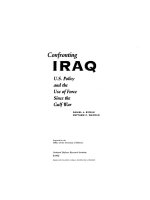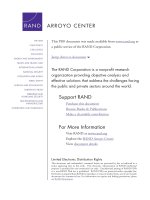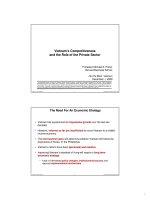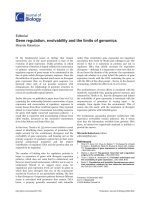Iraq, vietnam, and the limits of american power
Bạn đang xem bản rút gọn của tài liệu. Xem và tải ngay bản đầy đủ của tài liệu tại đây (5.52 MB, 238 trang )
Tai Lieu Chat Luong
Iraq, Vietnam, and
the Limits of American Power
This page intentionally left blank
Iraq, Vietnam,
and the Limits
of American Power
Robert K. Brigham
PublicAffairs • New York
Copyright © 2006, 2008 by Robert K. Brigham
Published in the United States by PublicAffairs™,
a member of the Perseus Books Group.
All rights reserved.
Printed in the United States of America.
No part of this book may be reproduced in any manner whatsoever without
written permission except in the case of brief quotations embodied in critical articles and reviews. For information, address PublicAffairs, 250 West 57th Street,
Suite 1321, New York, NY 10107.
PublicAffairs books are available at special discounts for bulk purchases in the
U.S. by corporations, institutions, and other organizations. For more information, please contact the Special Markets Department at the Perseus Books
Group, 2300 Chestnut Street, Suite 200, Philadelphia, PA 19103, call (800) 810-4145,
extension 5000, or e-mail
Designed by Mark McGarry, Texas Type & Bookworks
Text set in Dante
A CIP catalog record for this book is available from the Library of Congress
ISBN-13: 978-1-58648-499-6
First Edition
10 9 8 7 6 5 4 3 2 1
For my daughter,
Taylor Church Brigham
This page intentionally left blank
Contents
Preface ix
Chapter One
America Goes to War 1
Chapter Two
The Military Half 35
Chapter Three
The Problems of Nation Building 69
Chapter Four
Staying the Course 109
Chapter Five
Challenges to America’s Power 149
Acknowledgments 181
Notes 183
Index 205
This page intentionally left blank
Preface
After five years of conflict, the war in Iraq is not another Vietnam. It
is far worse. Having the experience and lessons of Vietnam as a
guide, the Bush administration charged headlong into a protracted
war with little regard for history or the limits of U.S. power.
The first edition of this book raised the question of whether Iraq
would turn into a war with the corrosive characteristics of Vietnam.
That is no longer the issue. The Iraq War has created an array of
new problems, and the United States will be coping with them for a
generation, just as it had to struggle with the consequences of Vietnam. In this book, I argue that the Bush administration, in fighting a
war of choice, has limited future U.S. foreign policy options, a limit
that will have disastrous consequences. Americans may turn inward
following the Iraq War, fearing that engagement with the outside
world might lead to another protracted conflict with limited results.
There will likely be an Iraq syndrome that matches the self-imposed
foreign-policy restrictions and national malaise that followed Vietnam.
PREFACE
Hearing echoes of Vietnam, the United States refused to intervene
to stop genocide in Cambodia, the Balkans, and Rwanda before it
was too late for hundreds of thousands of innocent people. The
great tragedy of the Iraq War is that foreign policy blunders there
may limit U.S. military action where it may be required later.
Furthermore, the United States has set back its Middle East
agenda considerably. Once seen as an honest broker in the Middle
East, the United States under the Bush administration has squandered its power and reputation in the region by mishandling the war
and regional diplomacy. Whatever gains the United States made
in the Middle East during the 1970s, 1980s, and 1990s were quickly
washed away by a misguided policy based on naive assumptions
about the role of the United States in the world and its ability to promote change through military power alone. The recent military
surge in Iraq has produced some victories and increased security in
some places, but it has not had much impact on the Baghdad government. Prime Minister Jawad al-Maliki has not created the kind of
legitimate political institutions necessary to guarantee a civil society
inside Iraq. Baghdad has simply focused too much on security issues
and not enough on political legitimacy and institution building. Furthermore, the White House has refused to build the architecture
necessary to find a political solution through the construction of a
government of reconciliation and concord. Exacerbating this problem has been the Bush administration’s outright rejection of a role
for the United Nations.
There will also be a domestic price for choosing war in Iraq. Paying for the war will be a burden on the country and its taxpayers for a
decade. The U.S. economy has been in a tailspin for much of the war,
PREFACE
following years of unprecedented economic growth, proving the old
adage that it is difficult to have both guns and butter. Huge budget
deficits and the price tag of trillions of dollars for the war in Iraq during the Bush years will require fiscal restraint and sacrifice in the near
future. The United States now faces an economic recession fueled in
part by the war in Iraq. In addition, domestic politics have become
even more partisan and divisive. Democrats in Congress and Republicans in the White House have failed to act on the mandate for
change in Iraq given to them by American voters in the 2006
midterm elections. Voters now want to move beyond this partisanship and overwhelmingly favor an end to the Iraq War.
Even after five years of conflict, it is quite likely that the end of
the Iraq War will combine an escalation of violence with a negotiated U.S. withdrawal that leaves the major political questions of the
war unresolved. The end result may be a bloody civil war in Iraq
with regional and international consequences. Rather than spreading
democracy throughout the region, the United States has, in fact, introduced greater instability with increased political and military
pressure on America’s Middle Eastern allies. And America’s enemies
will be emboldened, not because of U.S. military weakness, but because of recklessness in Washington. The progressive impulse in
American foreign policy has led to the realization in some circles that
there generally is no political corollary to American military strength
when the United States engages in nation building abroad.
The lesson Iraq teaches us, then, if we care to listen, is that the
United States should not use its overwhelming power arbitrarily. A
mature nation, a nation with a proper sense of its own history and
power, does not engage in wars of choice. It is now time for the
PREFACE
United States to reorient its power in the Middle East and to engage
the world as a superpower with a clear sense of its mission. The first
step is to create a framework for successful statecraft. For eight years
the Bush administration has refused the diplomatic path in the Middle East. Now is the time to reverse that decision. It will take a decade for the United States to reestablish its power and prestige, but
with bold leadership, such change is possible.
America Goes to War
P
RESIDENT
GEORGE W. Bush took the United States to war in Iraq
with soaring rhetoric about American ideals and deep-seated fears
about security. He used heightened threat perceptions created by the
horrific events of September 11, 2001, to make war against Saddam
Hussein’s Iraq and a global terrorist network a necessity. By linking
Saddam’s brutal rule with international terrorism—a connection that
did not exist—the president was making the case for a preemptive
strike against Iraq. The Bush administration convinced a majority
of the American people and Congress that the United States would
be more secure with a preventive strike against Baghdad. Furthermore, President Bush argued that the absence of democracy in the
Middle East had given rise to terrorism and that it was his responsibility to change the course of history by using American power to overwhelm a tyrant who had aided and abetted the enemies of freedom.
The Bush White House believed that the world would support his
decision to strike Iraq because U.S. interests matched global security
IRAQ, VIETNAM, AND THE LIMITS OF AMERICAN POWER
needs. Rejecting the lessons of Vietnam, the president and his top advisers saw no limits to American power as an instrument of global
transformation. They also believed that the United States would be
welcomed as a liberator in Iraq, and that once victory was secured
there, the rest of the Middle East would follow suit because the
move toward democracy was the goal of all peoples.
Iraq, then, is not an aberration. Rather, it is part of a pattern of
beliefs in U.S. foreign policy grounded in the principle that American ideals are universal and that U.S. power should support and expand those ideals around the globe. What separates Iraq from past
American conflicts, however, is the Bush administration’s revolutionary goal of democracy promotion through unilateral, preemptive
military action. Few presidents have engaged in a war of choice to
promote democracy because the linking of power and ideals—
democracy, freedom, liberty, capitalism—has not always produced
the best results. Larger wars for ideas could be long on rhetoric and
short on prudent judgment.1 Still, the Bush White House argued that
it could overcome years of realist compromises with tyranny by
following the neoconservative agenda. A more muscular foreign
policy would include promoting democracy in the Middle East, by
force if necessary. The confidence in the power of the United States
to expand American ideals required the Bush administration to reject any lessons that Vietnam had to offer. Instead of viewing the war
in Vietnam as an example of the limits of American power, the
Bush White House believed Vietnam was a warning that policymakers had to have the right dedication to victory. Therefore, confidence about the mission in Iraq was a fundamental tenet of Bush’s
foreign policy.
America Goes to War
Despite the Bush administration’s more incendiary foreign-policy
objectives, Congress treated war resolutions on Iraq and Vietnam
similarly. In both wars, Congress granted the president unusual
authority to wage war in its name. And within months of the start of
the wars, the original justification had been discredited. In each case,
this discrediting of the justification did not lead to a careful policy review. Instead, as the history of both conflicts shows, U.S. policymakers in the White House rejected carefully calibrated debates about
U.S. security interests in favor of idealistic appeals for war. If Vietnam and Iraq can teach us anything about the way the United States
goes to war, it is that Congress should insist on a full and frank debate before giving the president broad authority to wage war. Congress should better learn how to discipline power and harness fear.
The presidency has grown increasingly imperious over the last several decades, and it is now time for Congress to take its rightful place
in the foreign-policy process or risk more misadventures.
THE BUILD-UP TO VIETNAM: FROM THE
DOMINO THEORY TO THE DOCTRINE OF CREDIBILITY
It was, after all, the fear of falling dominos and lofty rhetoric about
America’s moral obligation to oppose communist aggression that led
to the Vietnam War. Despite the nation’s enormous military power
and strategic dominance, many U.S. policymakers feared that the
communists could marshal greater force or be more seductive than a
democratic country. Eisenhower’s secretary of state, John Foster
Dulles, saw the cold war in apocalyptic terms that pitted the forces of
good against the forces of evil. He was convinced the United States
IRAQ, VIETNAM, AND THE LIMITS OF AMERICAN POWER
had to combat atheistic communism with all its military might because the communists knew no moral law and would stop at nothing
in their quest for world domination. For Dulles, Christian ideals provided the dynamic difference between success and failure in the setpiece battle against communism. He argued that the only hope of
defeating the Soviets and Chinese lay in “reacting with a faith of our
own.” Dulles was firm in his convictions. “If history teaches us anything,” he concluded, “it is that no nation is strong unless its people
are imbued with a faith. . . . The impact of the dynamic upon the
static . . . will always destroy what it attacks.”2
The domino theory and a sense of messianic mission drew the
United States to war in Vietnam. The conflict was not a quagmire in
the 1950s but rather a noble mission in the eyes of the Eisenhower
administration to save Southeast Asia from communism. U.S. leaders
were so confident about the righteousness of their cause that on several occasions they failed to ask serious questions about the limits of
U.S. power or the legitimacy of the domino theory. Support for the
Eisenhower position in Vietnam was universal; Democrats and
Republicans in both houses of Congress stood behind the domino
theory. Senator John F. Kennedy, speaking before the American
Friends of Vietnam in 1956, warned that Indochina “represents the
cornerstone of the Free World in Southeast Asia, the keystone to
the arch, the finger in the dike. Burma, Thailand, India, Japan, the
Philippines and obviously Laos and Cambodia are among those
whose security would be threatened if the red tide of Communism
overflowed into Vietnam.”3
So confident was the United States in its moral and military position that it rejected any political settlement of the growing crisis in
America Goes to War
Vietnam. By 1954, the French government had grown weary of its
war against Ho Chi Minh’s communists for political control of Vietnam. The French had first come to Indochina in the 1850s, seeking
an Asian jewel for their imperial crown. After one hundred years of
colonial rule, Paris signed an armistice with the Vietnamese communists at a conference in Geneva that promised a French withdrawal
and unifying national elections in Vietnam. The Eisenhower administration rejected the Geneva Accords, however, believing the United
States could fare better than the French against the communists because it was not burdened by a colonial past and because providence
was on its side.4 Accordingly, the United States presided over the
birth of the Republic of Vietnam, or South Vietnam, as a counterrevolutionary alternative to Ho Chi Minh’s communists. Dulles and
Eisenhower therefore linked the American mission in Vietnam with
American ideals. Anticommunism and the promotion of democracy
along liberal lines were both a justification for war and the cornerstone of U.S. ideology.
In 1961 the new Kennedy administration engaged in a formal policy review of its options in Vietnam. Kennedy had been a longtime
supporter of the domino theory and was clearly worried about communist advances in newly emerging postcolonial nations in Africa
and Asia. The president and his advisers ultimately rejected the
domino theory, however, believing there were situational differences
in geography that could overcome politics.5 In other words, Kennedy
was less concerned about falling dominos because he no longer believed that they were attached. If one nation fell to communism, it
did not automatically mean that neighboring countries would fall.
What replaced the domino theory in Kennedy’s mind, however, was
IRAQ, VIETNAM, AND THE LIMITS OF AMERICAN POWER
his new thinking on U.S. credibility, what writer Jonathan Schell appropriately called the “psychological domino theory.”6 Kennedy believed the war in Vietnam was no longer about stopping dominos
from falling but rather about showing enemies and allies that the
United States lived up to its commitment “to pay any price and bear
any burden” . . . to ensure “the survival and success of liberty.”7 Support of South Vietnam, not rolling back communism, became the
new goal.
Perhaps Kennedy’s two national security secretaries were most
forceful in advocating the new policy. Secretary of State Dean Rusk
often used protocols of the South East Asia Treaty Organization
(SEATO) as sufficient reason for U.S. intervention in Vietnam.
According to Rusk, provisions in the 1954 SEATO agreement demanded that the United States come to the defense of any of the signatories.8 Since South Vietnam had signed this agreement, the
United States was obligated by treaty to defend it from communist
attacks. Rusk further reasoned that if the United States did not aid
South Vietnam, U.S. allies across the globe would come to doubt the
U.S. commitment to its treaty obligations. Rusk was particularly
worried that U.S. allies in NATO (the North Atlantic Treaty Organization) might wonder if Washington would stand behind that agreement should the Soviets invade another country in Europe.
Secretary of Defense Robert S. McNamara argued that if the United
States did not intervene in Vietnam, both sides of the Iron Curtain
would sense “a major crisis of nerve.”9 In a report to the president,
McNamara concluded that “the loss of South Vietnam would . . .
undermine the credibility of American commitments elsewhere.”10
America Goes to War
By 1961, according to historian Fred Logevall, the doctrine of credibility had “supplanted the domino theory in American thinking
on Vietnam.”11
LIMITED WAR THEORY
This change in rationale also brought with it a change in strategic
thinking. Throughout the Eisenhower years, U.S. foreign policy had
been based on the concept of mutually assured destruction (called
MAD). The president believed if he built up the American nuclear arsenal so that it could withstand a first strike from the Soviets,
Moscow would be deterred from aggressive action. Although the
“New Look,” as Eisenhower’s policy was called, did keep the United
States out of major confrontation with the Soviets, it also limited the
president’s options. Kennedy argued he needed a more flexible
policy—one that more accurately reflected the needs of an administration willing to meet the Soviet threat anywhere around the globe.
Kennedy envisioned a strategy that would allow the United States to
act quickly and decisively against communists in the jungles of
Southeast Asia and on the plains in Africa.12 However, Kennedy did
not want these confrontations to lead to a nuclear exchange with the
Soviets. Any local war with a country inside the fraternal socialist
world system risked a larger war with China or the Soviet Union.
Since the Soviet Union possessed nuclear weapons, the balance of
terror limited U.S. policymakers in their actions.
At the time, most foreign affairs decisions were seen through the
prism of the cold war and the limitations it presented. The primary
IRAQ, VIETNAM, AND THE LIMITS OF AMERICAN POWER
national security issue of the era was preventing a catastrophic war
that might well escalate into a nuclear war with the Soviet Union.
The Kennedy administration balanced the need to confront Soviet
meddling in newly emerging postcolonial nations with the need to
avoid a nuclear exchange with the communist camp through what it
called “limited-war theory.”
The product of American academics Robert Osgood, Thomas
Schelling, and Herman Kahn, limited-war theory gave the president
a way to keep wars local and thereby avoid a nuclear showdown.13 At
the heart of this new doctrine was the belief that the president
should have the option to respond to Soviet aggression at a low level
of violence or through diplomacy. The president could move up the
rungs of a ladder of escalation, until such time as the enemy chose
to cease and desist its activities rather than face the consequences of
further escalation.14 With enough applied military pressure, according to the theory, the president could communicate with the enemy
that it would pay a high price if aggression continued. In the case of
Vietnam, the goal was to convince Hanoi that continuing to support
the revolution in the south would come at too high a price. Each military escalation, therefore, was a signal to Hanoi to cease and desist.
Of course, Hanoi rejected Washington’s signals, matching each military escalation with its own.15
U.S. fears were not limited to Moscow’s cold war power or influence. China was a legitimate threat to American troops in Vietnam.
McNamara was convinced during the war that invading North Vietnam with U.S. ground forces carried with it unacceptable risks.16 He
correctly concluded that China would act in its own self-interest and
would consider any attack across the seventeenth parallel that divided North Vietnam from South Vietnam an attack against its own
America Goes to War
borders.17 General Bruce Palmer, General William Westmoreland’s
deputy in Vietnam, agreed. He argued in his book The Twenty-Five
Year War that “one cannot quarrel with the decision not to invade
North Vietnam because it was too close to China.”18 U.S. officials
now know that North Vietnam asked for and received security commitments from Beijing from 1960 onward.19 They also know China’s
Seventh Air Force was moved permanently to the Vietnamese border
in case of a ground attack across the seventeenth parallel.20 Four
other air divisions were also moved closer to the border, and Beijing
built two airstrips near Lang Son in anticipation of an American invasion.21 By 1968, over two hundred thousand Chinese troops were
serving within North Vietnam’s borders.22
Kennedy changed not only the rationale for war but also its
strategic doctrine. In rejecting the domino theory in favor of the
theory of credibility in the struggle against international communism, the president was willing to give up North Vietnam to protect
South Vietnam. He was also willing to limit the U.S. military commitment to Vietnam to avoid a larger war that might entice China
and the Soviet Union to join the conflict. The second-order issue—
protecting South Vietnam from a communist takeover through the
application of limited U.S. military pressure—proved more difficult
to accomplish than anyone in the Kennedy administration had originally thought. The South Vietnamese government of president Ngo
Dinh Diem was corrupt, inefficient, and not very democratic. Diem
did little to reach out to those who were in the minority view on
some issues.23 He persecuted Buddhists, believing that they were
sympathetic to the communist cause, he rejected land reform programs supported by the United States, and he closed down newspapers that were critical of his rule.24
IRAQ, VIETNAM, AND THE LIMITS OF AMERICAN POWER
EXPANSION OR WITHDRAWAL?
By the middle of 1963, a frustrated John F. Kennedy was considering
another major policy revision. First on Kennedy’s list of things to
change in Vietnam was President Diem. Despite some support in his
administration for staying the course with Diem and his brother, Ngo
Dinh Nhu, there was overwhelming backing for regime change in
Saigon.25 Many Kennedy officials believed the U.S. counterinsurgency
war was doomed with Diem at the helm.26 Others argued that the political war so essential to victory was being lost every day because
Diem cared little for the village war or for peasants caught in the conflict.27 What Kennedy envisioned for Diem is still debatable; perhaps
he believed the South Vietnamese president would be replaced in a
bloodless coup. In the end, however, Diem’s own officers executed
him and his brother in the back of an armored personnel carrier.
After Diem’s assassination, events in Saigon spun out of control.
Various political groups wrestled for power in the capital, and the
communists made significant advances in the countryside. In fact,
the Communist Party hoped to take advantage of the chaos in
Saigon. At its December 1963 plenum, party leaders agreed to “escalate the level of armed struggle in the South.”28 According to party
leaders, “Armed struggle would be the direct and deciding factor in
the annihilation of the armed forces of the enemy.”29 Le Duan, the
party’s secretary general and a longtime advocate of a more forceful
military policy in South Vietnam, applauded the decision.
As Hanoi turned up the heat, the Kennedy administration considered its options. One option was to withdraw. Convinced South Vietnam would eventually “throw our asses out,” and needing to score
some political points without a huge military cost, Kennedy had con-
America Goes to War
sidered a limited withdrawal as early as 1962.30 By April 1963, some
administration officials suggested that withdrawing a thousand U.S.
advisers “out of the blue” would reassure the American public the
war was going well and would undercut the communists’ “best propaganda line,” that the United States was running the war for South
Vietnam.31 Kennedy had McNamara draw up the plans for the limited withdrawal to begin in December 1963. Many believed the president was starting to phase out U.S. operations in Vietnam, and that
after the 1964 presidential election he would withdraw all U.S. advisers. McNamara went on record stating he was convinced Kennedy
would have withdrawn U.S. forces had he been reelected.32 No one
will ever know. Kennedy was assassinated on November 22, 1963.
Of course, Kennedy had another option, which was to intervene
more forcefully. With just over sixteen thousand U.S. advisers in Vietnam, it was clear that more could be done to prop up the Saigon government and to aid the South Vietnamese armed forces. From the
earliest days of the administration, some of Kennedy’s key advisers
had advocated a more militant line.33 By the summer of 1963 many
were calling for the president to introduce U.S. ground troops to take
over the war from the South Vietnamese forces and to save Saigon
from total defeat.34 Others suggested that a strong air campaign over
North Vietnam would take some pressure off South Vietnam.35 It
now seems clear Kennedy refused to ask the hard questions about
American intervention in Vietnam, content instead to continue to
steer a middle course that promised neither withdrawal nor greater
involvement.
When Lyndon B. Johnson entered the Oval Office, he, too, could
have expanded the war or withdrawn. In typical Johnson fashion, he
IRAQ, VIETNAM, AND THE LIMITS OF AMERICAN POWER
chose neither course. Always wanting to keep his options open,
Johnson usually took the path that limited his policy choices. The
president and his national security advisers decided to continue
Kennedy’s commitment to the defense of South Vietnam and to
keep America’s role in the war limited. On March 17, 1964, Johnson
outlined his decision in what is now known as National Security
Memorandum No. 288.36 Expanding on Kennedy’s redefinition of
the war’s aims, Johnson argued that nothing short of U.S. credibility
was at stake in Vietnam. The administration would continue to support South Vietnam in its hour of need, the president concluded, because the United States was the only power that could do so. In the
face of danger, the United States never backed down. Rusk perhaps
put it best when he argued that the “integrity of the U.S. commitment is the principal pillar of peace throughout the world. If that
commitment becomes unreliable, the communist world would draw
conclusions that would lead to our ruin and almost certainly to a catastrophic war.”37 America’s war aims in Vietnam during the Johnson
years were still focused on containment and credibility.
Thus, U.S. goals in the Kennedy and Johnson years were counterrevolutionary. First, the United States wanted to stop the spread of
communism in Southeast Asia, and then, after rejecting the domino
theory, U.S. policymakers wanted to stop the communists from taking over South Vietnam. As the war dragged on, the chief goal became convincing enemies and allies that the United States honored
its treaty commitments. Credibility was as important as the specific
military mission. Containment, preservation, and credibility were
the hallmarks of America’s war aims in Vietnam. Only in building up
South Vietnam as a viable alternative to Ho Chi Minh’s communists
did the United States move from the defensive to the offensive.









